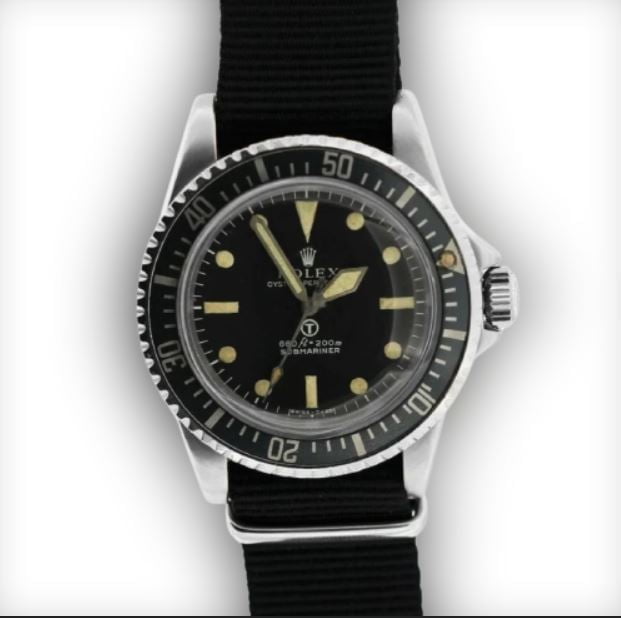
The desire to keep time accurately has always been a major goal for mankind.
The military has been an early adopter of this technology as precision timing was of utmost importance in the operations of a successful army. Since the dawn of the wristwatch in the late 19th century, the military has been utilizing this tool in more ways than one.
From keeping time during night patrols to synchronization of maneuvers and operations, military watches have been an essential instrument and a key part of numerous military operations throughout the decades and centuries.
In this piece let’s take a look back on the history of military watches, tracing its origin up to some of the most famous and iconic models that still exist today. I'll delve into the evolution of these timepieces and the hallmark features and technologies that have been used in military watches. Plus, we’ll also explore the various watch models most famously used by the military through the years and why they remain as popular as ever.
Quick Review of Key Points
Military watches have been used since World War I. Popular models include the Rolex MilSub, Omega Seamaster, Hamilton Khaki Pilot and Panerai Luminor Marina. I'd love to own one of each, as we probably all would.
The History of Military Watches
The history of military watches dates back to the earliest days of warfare. During the early years of combat, soldiers were required to have a reliable timepiece in order to accurately synchronize their attacks and movements. As timekeeping technology advanced, so did the functionality of military watches. Today, there is a wide range of specifications available for military watches, including water-resistance, shock-resistance, precision accuracy, and more.
One side would argue that military watches have been essential for efficient battlefield operations throughout history. Watches enable commanders to coordinate strikes and keep track of schedules more effectively than if they had only relied on verbal commands. Watches also provide soldiers with a sense of accomplishment when completing goals and duties within a certain timeframe.
The opposite opinion would be that requiring service members to wear a watch could lead to distractions in battle or an overestimation of performance due to inaccurate readings. Additionally, while most modern military watches are capable of withstanding extreme temperatures and conditions, they may still malfunction or require repair at inopportune times.
Regardless of which side one might take in this debate, the evolution of the military watch from its early beginnings until now has been undeniably impressive. From its original purpose as simply a way to tell time on the battlefield, it has become an invaluable tool for coordinating operations and personnel around the world in real-time. With that in mind, it can be said that military watches have been instrumental in ensuring success by allowing commanders to plan strategically and efficiently deploy forces as needed. And with this brief look at its history out of the way, let's now turn our attention to the origins and early uses of military watches.
Most Important Points to Remember
Military watches have been an invaluable tool throughout history in battlefield operations, allowing commanders to coordinate attacks and plan strategies, while also providing soldiers with a sense of accomplishment. Although they offer great utility, there are potential downsides such as causing distractions in battle or malfunctioning at inopportune times. Regardless, the evolution of the military watch has been impressive and its origins and early uses should be further explored.
Origins and Early Uses
Military watches have been around for centuries and their utility, precision, and their ability to withstand extreme conditions has made them an invaluable tool for members of the armed forces. The earliest examples of military watches date back to 1844 when Adolphe Nicole created a compact chronograph made specifically for the French Dragoons, who were in need of a reliable timepiece during long treks. Since then, military watches have been used in a variety of different roles, from keeping World War I pilots on schedule to helping parachutists accurately track their altitude during missions in World War II.
Early military watches were also designed with aesthetics as well as performance in mind and they became something of a fashion statement amongst soldiers. By the mid-19th century, watchmakers had perfected the art of waterproofing pocket watches, allowing soldiers to keep their timepieces slung safely across their chests during heavy duty operations such as battles. Many of these early military watches were crafted by renowned watchmakers such as Breitling, Omega, and Longines, who all placed emphasis on ensuring that their creations remained both reliable and visually appealing.
The importance of accurate timepieces was reinforced throughout history as more wars broke out and advances in technology emerged. Watches became indispensable tools for keeping order during battle; from coordinating troop movements to mapping out tactical strategies, a reliable time reference was essential for victory. From this necessity came the birth of even more specialized watch models developed specifically for naval officers, including waterproof chronographs infused with quartz technology and dive watches designed especially for U-boat commanders navigating the Atlantic.
Today’s military watches are just as crucial a part of modern warfare as they were two centuries ago. Whether bombing missions require ultra-precise navigation or special ops teams need cutting-edge communication devices attached to their wrists – there is no doubt that contemporary militaries are still using cutting-edge wristwatches as they conduct operations worldwide. Keeping tabs on advances in technology is important if armed forces are going to stay one step ahead of their adversaries; with continued innovaton and rising consumer demand, this type of valuable equipment will remain relevant for many years to come.
Next, we'll be taking a look at the development of military watch technology over the course of two World Wars and its influence on modern watch designs today.
World War and Modern Watches
The twentieth century marks a period of significant innovation and development for wristwatches in the military. During World War I and World War II, watches were used to assist in navigation, provide support to reconnaissance teams, and provide valuable information that could be used strategically on the front lines. During the war, watches were eventually issued to all soldiers, adding to their arsenal of weaponry.
Wristwatches were favored by the military during these world wars due to their convenience of accurate timekeeping and portability. By having access to reliable timepieces at all times, it was easier for soldiers during missions to better coordinate with each other. In addition, when used as navigational tools, watches offered precise information that helped soldiers traverse terrain effectively and precisely identify geographic coordinates accurately.
Most modern-day watches used for military purposes continue these trends introduced during the early world wars. They are designed with more durable materials including shockproof technologies so that they can handle extreme elements. Modern watches also boast GPS capabilities and digital screens that can display various kinds of information utilized by multiple branches of the military for tactical operations.
Given their multifunctional capabilities and versatility of use, it is no surprise why military watches have become a popular item amongst civilians in recent years. Watches are no longer simply a tool for keeping time, but also an ideal tool for individuals who enjoy athletic activities and adventures outdoors. Looking forward into the future, there is still much potential for advancing military watch technology as they remain an important part of any soldier's equipment kit.
Now, let's take a closer look at some of the most famous models in history that have shaped the industry over time - this will be discussed in the following section about: "The Most Famous Models".
- The first watches designed for military use were created in the late 19th century by Swiss watchmakers.
- The most iconic military watch is the Rolex Submariner, first issued to British Royal Navy divers in 1953.
- According to a study published in 2017, military watches, especially vintage models, have become increasingly popular as collectable items due to their high quality, historical significance, and aesthetic appeal.
The Most Famous Models
Military watches have always been characterized by their exceptional durability and resistance. Many of the models that have gained historical significance in recent years represent the peak of these characteristics, with incredibly precise and reliable features that served soldiers both on and off the battlefield.


The most famous models include the Omega Seamaster 300M, the Rolex Submariner (Mil-Sub), Panerai Luminor Marina, Junghans B-Uhr Type WW2, Hamilton Khaki Field Mechanical, Longines Hydroconquest Professional, Oris Big Crown Pointer Date, Sinn 556i Military, and Breitling Super Avenger II. All of these watches boast distinct features that allow them to stand out among other models in the military watch market.
The Omega Seamaster 300M is highlighted for its advanced waterproofing capabilities, which allows it to withstand harsh environments or depths up to 3000 feet. The Rolex Submariner is distinguishable by its iconic design aesthetic in a range of sizes and materials. Similarly, Panerai Luminor Marina stands out for its distinct 44mm case and contrasting colors.
The Junghans B-Uhr Type WW2 has become increasingly popular thanks to its unique dial size bezels and classic markers. The Hamilton Khaki Field Mechanical watch is widely credited with setting a new standard with its minimalist design. And moving onto Longines Hydroconquest Professional, this model stands out due to its signature blue dial and date display window.
As for Oris’s Big Crown Pointer Date, this model carries all classic style but updated with modern materials, such as stainless steel components along with a rubber strap for better comfort. Additionally, Sinn 556i Military incorporates a high tech scratch resistant coating for users seeking added safety. Finally there’s Breitling Super Avenger II: This model boasts impressive aviation-inspired technologies from chronograph functions to integrated trip meter and second time zones to set it apart from other military watches and draw in veteran pilots seeking an iconic battle buddy on their wrist.
The aforementioned models are undoubtedly some of the most valuable military watches to possess within collector circles though they also remain highly sought after by active forces deploying into the field; regardless of the audience these classic pieces will continue to remain meaningful mementos of past eras heroes both real life or fictional yet nonetheless loyal companions suited up for any mission present or future. As such let us now move on to look at how quartz vs mechanical movements play into defining these watches historical value within specific contexts as well as how they drive contemporary designs alike.
Quartz vs. Mechanical Movements
Quartz and mechanical movements are the two major types of watch movements available today. Quartz watches, powered by a battery, are very accurate and often cost less thanks to their simple design. In comparison, mechanical watches run on winding springs and require more frequent servicing than quartz digital movements.
Mechanical watches are favored among collectors because they contain sophisticated and intricate components that move in harmony with one another. Because they may take years of experience to properly repair and maintain, they can be much more expensive than quartz or electronic watches. Their parts are crafted with incredible precision which is why many aficionados enjoy the ability to appreciate this worksmanship within a timepiece.
The debate between quartz and mechanical movement has seemingly been a hot discussion among watch enthusiasts for years but it shouldn’t be seen as an “either/or” situation. They both have their place in different segments of watch buyers and should be considered when selecting a timepiece based on personal preference and lifestyle needs.
Leaping into the next section discussing iconic Swiss design features, it is important to understand how the mechanics of the watch movement adds further complexity to designer timepieces.
United States Military Standard Watches


Military watchmaking has been a mainstay in the US since the late 19th century. In 1896, the US War Department issued “Standard Watches” to soldiers, which marked the start of a long line of military watches, known as the “United States Military Standard Watches” (USM). Known for their reliability and durability, these watches remain in demand today.
USM watches are considered some of the best military timepieces due to their singular focus on meeting basic specifications for accuracy and reliability. This utilitarian design has earned them a reputation for being exceptionally dependable and durable, even in the most extreme conditions. Additionally, many of the components used to make USM watches are still sourced from original manufacturers, ensuring their authenticity and quality.
Critics argue that the simplistic designs make them aesthetically unappealing for non-military use. However, many find these same features to be an asset when using a watch for tactical purposes. High visibility dials and luminous hands allow users to easily determine the time in any lighting condition and perform operations quickly and accurately.
It's no wonder why USM watches remain popular with military personnel as well as civilians who appreciate their rugged style and reliable performance. As we now transition into a look at Soviet Military Watches, keep in mind how precision engineering and high-grade materials were integral to the success of American watches throughout history.
This has set a standard for both defense and civilian uses which will now be explored with our next section about Soviet Military Watches Recap.
Soviet Military Watches Recap


The origins of military watches can be traced to the Soviet Union. Throughout its history, the Soviet Union produced a variety of military watches for its armed forces. From pocket watches in the 1930s to electronic models in the 1980s, these watches were designed for durability and accuracy.
Many of the most famous Soviet-made watches are often associated with The Great Patriotic War (also known as World War II). Before the war, the Soviets developed their first wristwatch, the “Vostok”, which served as a reliable timepiece and companion during battles. The famous “Pobeda” and “Raketa” models soon followed. These timepieces were popular and affordable during wartime, and many have been retained by collectors as functional antiques.
The 1960s and 70s saw a surge in production of quartz-powered digital watches, such as the Poljot "Sturmanskie". In spite of their technological advancement over mechanical pieces, these models were still made for ruggedness and performance. Further into the Cold War period, Timex built two model lines for special forces in both East and West Germany - G-SF 5610 from Soviet-era Chernomorets Factory and Kreigsmarine DAG 24S from Rostock Marinelliemaufzeugbau Factory.
In 1983, Soviet engineers released the "Elektronika 2" - a hybrid quartz-digital watch that became an instant classic due to its extreme performance capabilities. This device featured high water resistance rating of up to 200 meters and an illuminated display even in complete darkness. While these accomplishments have yet to be improved upon thirty years later, they set a standard for excellence among future watchmakers that was rarely equaled until now.
Through all these advancements in technology, one thing has remained true: Soviet military watches remain some of the most dependable tools ever created by man. Whether it is used as an heirloom or a daily use timepiece, these vintage models are sure to evoke nostalgia and wonder alike.
As we move ahead into the future of military watches, it's important to remember their storied history - a history dominated by Soviet Military Watches - and look to continued innovation in design and performance. The next section will discuss how modern technologies are being harnessed in order to create new forms of watch that bridge the gap between fashion accessory and technical tool for soldiers on the battlefield.
The Future of Military Watches
The future of military watches is a topic of intense debate. On one side of the argument, it's likely that the advent of smartwatches has rendered traditional military watches obsolete. Smartwatches have advanced capabilities, such as touchscreen displays and text messaging, connected to a larger device or platform—which means they can be used for more than timekeeping. Additionally, they are usually less bulky and more stylish than traditional military watches.
However, there are also arguments in favor of preserving the history and tradition associated with military watches—particularly because generations of soldiers and veterans have worn them since World War I. Military watchers offer precision timekeeping and are designed to resist extreme conditions—making them a reliable tool in times of war. Proponents also argue that these watches provide an important connection with military service members' history and heritage, which is an invaluable asset in times of peace.
It's clear that the debate about the future of military watches will continue for some time to come. That said, it does appear that despite waning interest in traditional design, there has been an increasing demand for simple yet reliable military-style watches in recent years. As a result, many watchmakers are now producing modern versions that blend classic design with technological features. With renewed interest from consumers, it is certain that military watches will remain an integral part of culture moving into the future.
Answers to Common Questions with Explanations
What specific features distinguish military watches from traditional watches?
Military watches tend to be more robust and utilitarian than traditional watches. They often feature large readable dials that are easy to read in low light and luminescent hands and markers for readability in the dark. Military watches generally have a case that is water resistant and able to withstand extended shock and vibration, which is essential for military personnel operating in challenging environments. Additionally, many military watches have an extra durable strap made of leather, nylon or metal designed to keep the watch securely on the wrist even in active use. These features help make military watches more reliable and suitable for the grueling conditions they may face on the battlefield.
What are some of the most iconic military watches from history?
Some of the most iconic military watches from history include the Rolex Oyster Perpetual (1941), the British WWW (Wrist Watch Waterproof) from 1940s and 50s, the MilSpec Smiths/Dennison W10 from 1945, and the Timex issued to U.S. troops during World War II.
The Rolex Oyster Perpetual was awarded to the Royal Air Force in 1941 for its pilots for precision and reliability navigating during night bombing raids. The British WWW watch was created for British soldiers fighting in World War II and featured a luminous dial, radium hands, a waterproof case, and a screw-down crown. The MilSpec Smiths/Dennison W10 was invented to enable RAF Air Gunners to measure elapsed time accurately in night fighter operations. Finally, Timex watches were issued to U.S. forces prior to their deployment overseas due to their affordability, accuracy, and durability.
What prompted the development of military watches?
The development of military watches was primarily driven by the need for reliable and accurate timepieces in battlefield situations. During World War I, it became necessary for soldiers to have a precise knowledge of time when planning and executing military strategies. Without reliable timepieces, communication between units and planning of operations would have been impossible. This spurred a wave of innovation in watch design, leading to the development of sophisticated military watches that could withstand the harsh conditions on the battlefield while providing accurate timekeeping. To help ensure accuracy, many of these watches featured luminous dials and hands, hackable movements, anti-magnetic properties and water-resistant cases.